As The Economy Recovers And The Labor Force Tightens, Passive Job Seekers Outnumber Active Job Seekers Four To One; Companies Can Reach Them With Audio, The Soundtrack Of The American Worker
According to the latest data from the Federal Reserve, job opening rates now exceed pre-pandemic levels as American unemployment continues to drop.
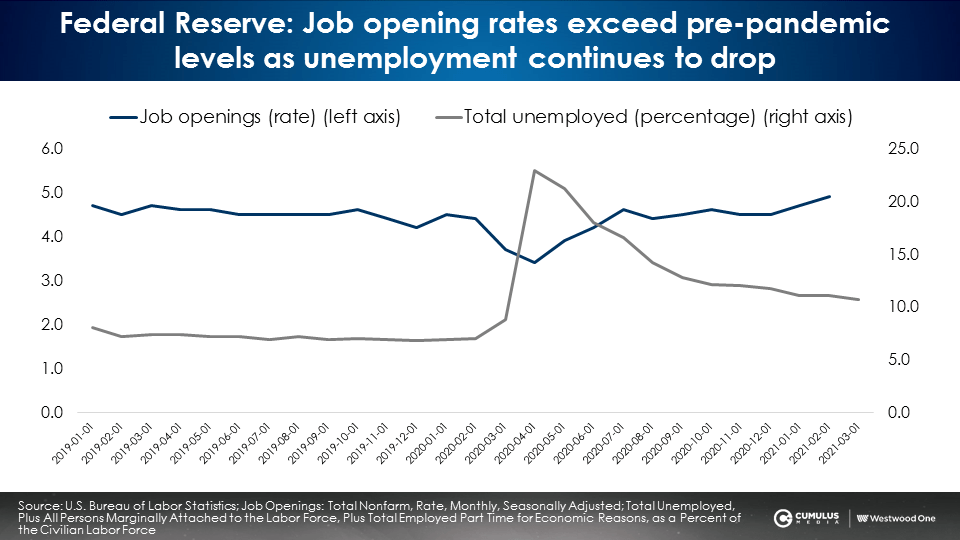
As of February 2021, the 4.9% job opening growth rate (shown in blue) surpassed 2019 levels. Total unemployment has dropped significantly and continues to trend down.
According to a recent article in the New York Times on the rebounding economy, “Some companies find themselves desperate for workers.” They point to the recovery of manufacturing as a turning point. “I’ve turned down a million dollars’ worth of work in the last two weeks,” says Matt Guse, owner of MRS Machining, a maker of precision metal parts in Augusta, Wisconsin. “I have open capacity, but I need more people.”
The Wall Street Journal also cites a tightening labor force to be of concern for companies. McDonald’s Chief Executive Chris Kempczinski says, “What we’re seeing in the U.S. right now is definitely a very tight labor market that’s putting pressure on both us and our franchisees.”
In light of the current economic state, now is the time for companies to start recruiting new employees.
To analyze the national employment ecosystem and profile the passive job seeker, CUMULUS MEDIA | Westwood One commissioned MARU/Matchbox to field a study in February 2021. 969 respondents were surveyed to explore changes in the labor market since the onset of the COVID-19 pandemic. These findings were compared to a similar study we conducted in April 2018.
Here are the key findings:
Passive job seekers are the #1 source of new workers in America and outnumber active job seekers four to one
As the name implies, passive job seekers are the one in two Americans who are not actively looking for a new job: “I might consider the right new job” (37%) or “I am definitely willing to consider a new job” (12%). There are four times more passive job seekers than active job seekers (49% versus 12%). As such, it is crucial that companies tailor their messaging and media plans to attract passive candidates.
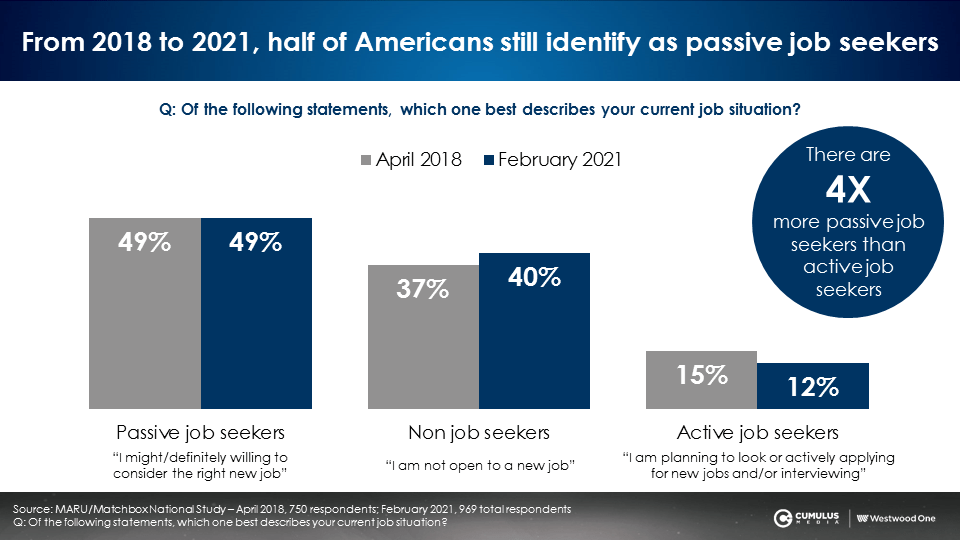
Flexible at-home and on-site work opportunities are most compelling to passive job seekers
Half of passive job seekers say the most attractive schedule is flexible with both at-home and on-site opportunities. A quarter of passive job seekers desire work from home opportunities while another quarter say they want to work outside the home. The fact that three-quarter of passive job seekers desire some form of work from home reveals home offices will continue long after the pandemic.
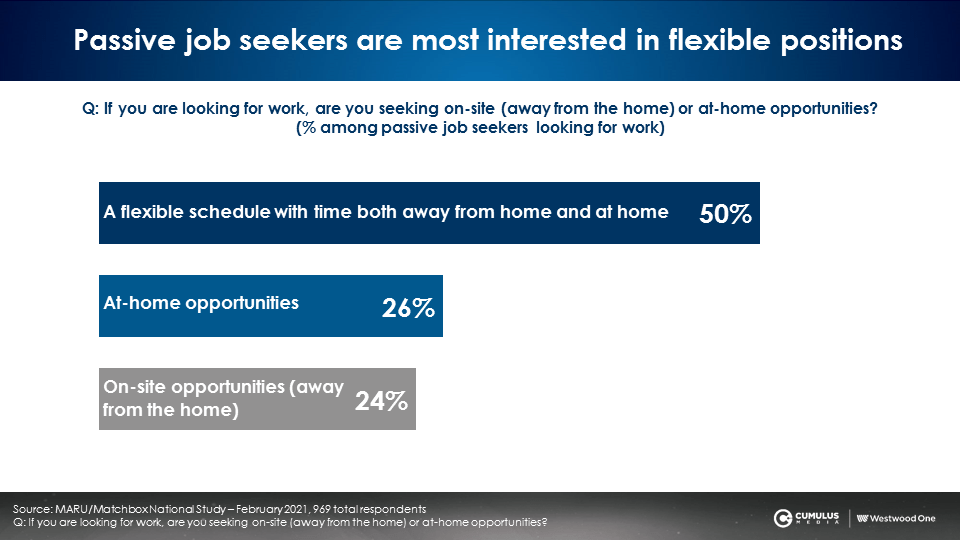
Passive job seekers are less likely to use online job sites
They don’t call them “passive” job seekers for nothing! Only a minority of passive job seekers use Indeed.com, LinkedIn, ZipRecruiter, and Glassdoor.
Companies who solely rely on online job sites to recruit new hires are missing out on a gigantic portion of the candidate pool that is four times larger than active job seekers. Adding over-the-air AM/FM radio, AM/FM radio streaming, and podcasts to the recruitment media plan can help secure these hard-to-reach candidates.
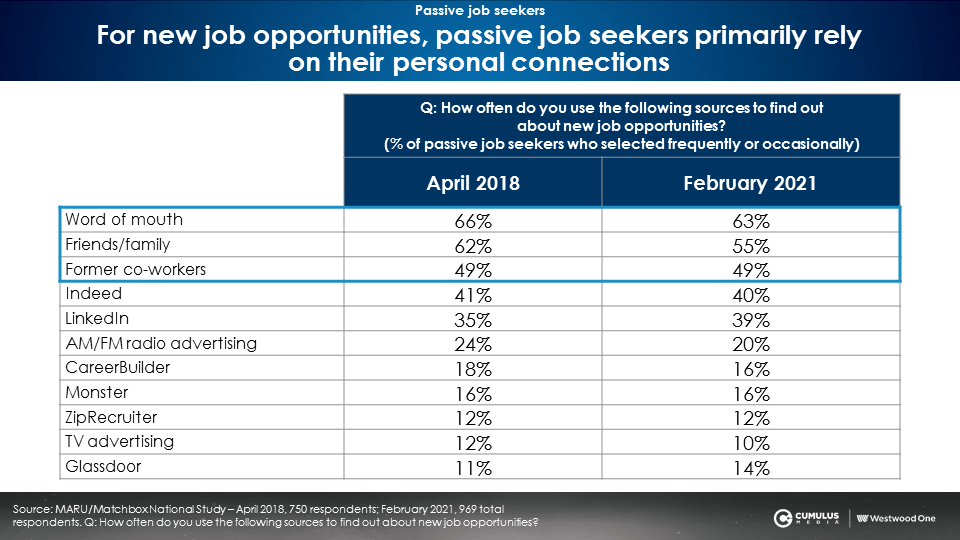
Passive job seekers are most aware of LinkedIn and Indeed
Over half of passive job seekers are not aware of most online job sites. 54% say they are extremely/somewhat familiar with LinkedIn. 48% are extremely/somewhat familiar with Indeed.
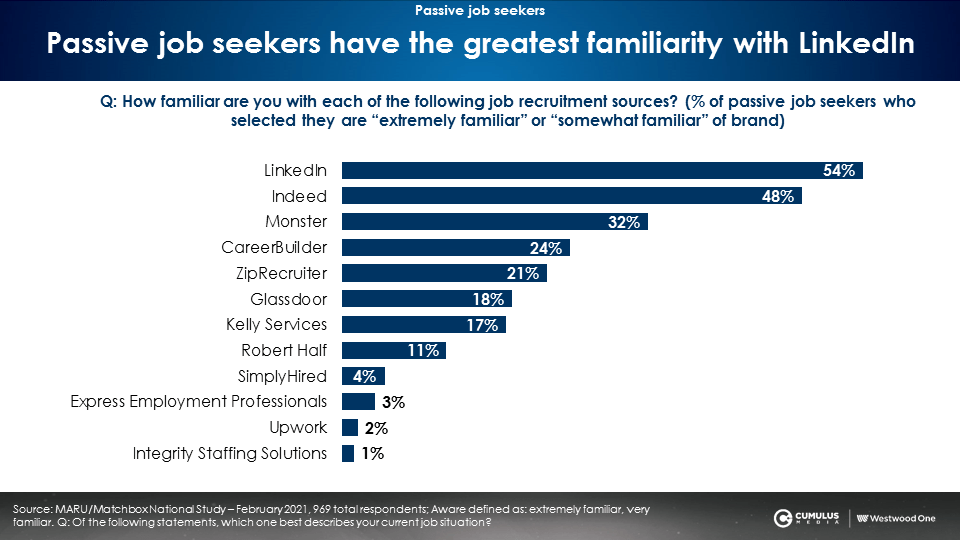
Twice as many passive job seekers indicate that they consider AM/FM radio as a source for job opportunities compared to TV (20% versus 10%).
Among active job seekers, it’s a two-horse race for familiarity and usage between LinkedIn and Indeed
Not surprisingly, active job seekers show higher awareness of online job sites. Two-thirds say they are extremely or somewhat familiar with LinkedIn and Indeed. 40% are aware of CareerBuilder, Monster, and ZipRecruiter. A third are familiar with Glassdoor.
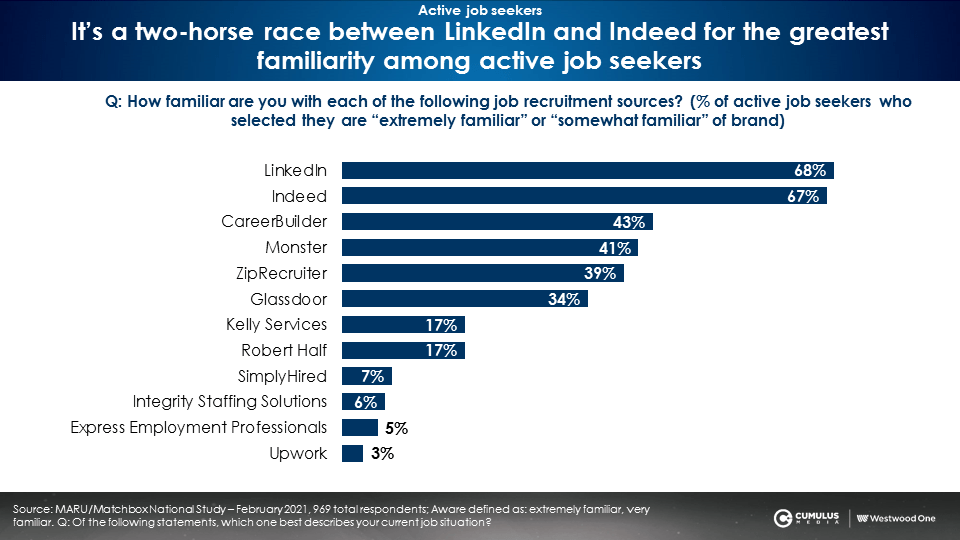
Among active job seekers, 62% say they use Indeed and 57% use LinkedIn. There is a way four-way tie for second among ZipRecruiter, CareerBuilder, Monster, and Glassdoor.
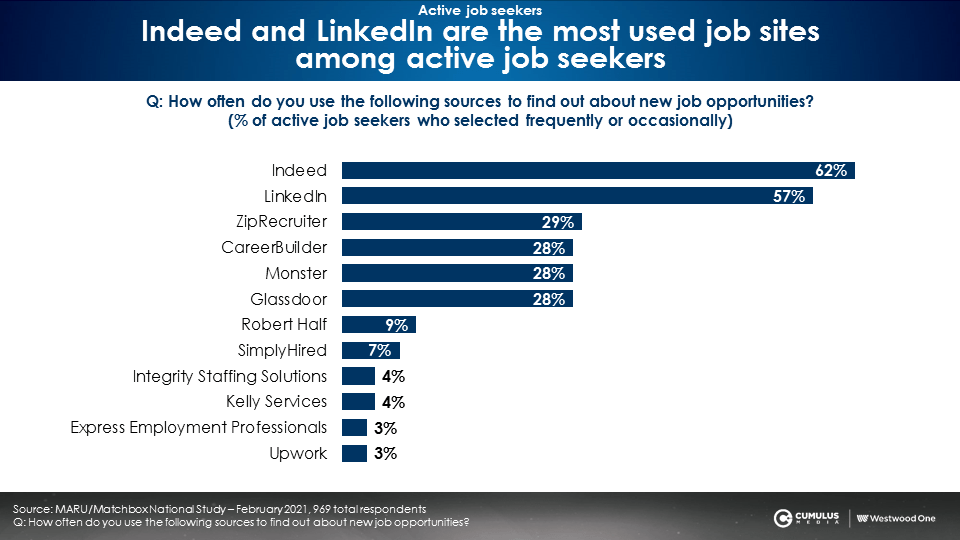
Audio is a great way to reach active and passive job seekers
AM/FM radio has been called “the soundtrack of American worker” as the majority of listening is from people who work. Over-the-air AM/FM radio, AM/FM radio streaming, and podcasts are strong platforms to reach both active and passive job seekers.
AM/FM radio reaches over eight out of ten passive and active job seekers. Among passive job seekers, 39% listen to AM/FM radio streaming. Half of active job seekers listen to AM/FM radio streaming. One-third of passive job seekers listen to podcasts and 38% of active job seekers are podcast listeners.
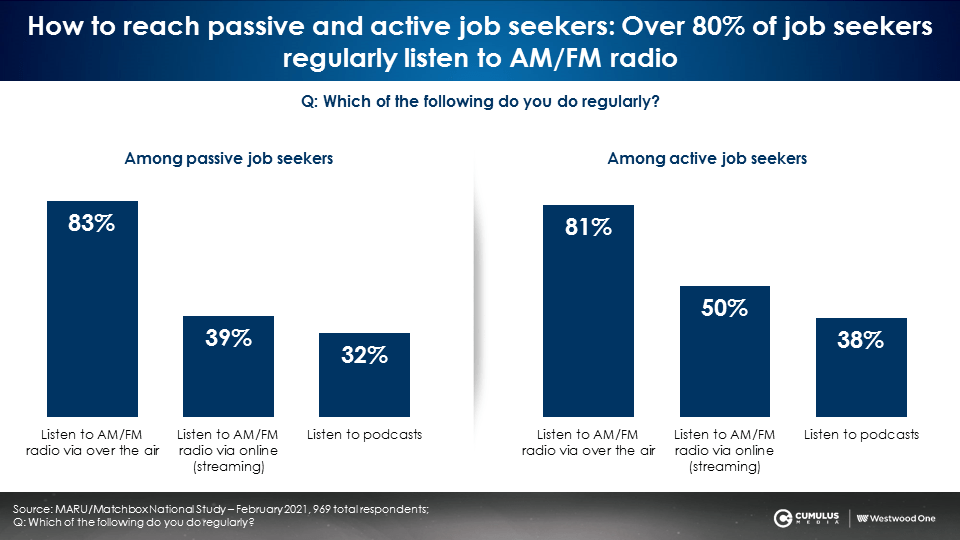
While AM/FM radio has the strongest reach among job seekers, digital audio in the form of AM/FM radio streaming and podcasts indexes strongly for both passive and active job seekers.
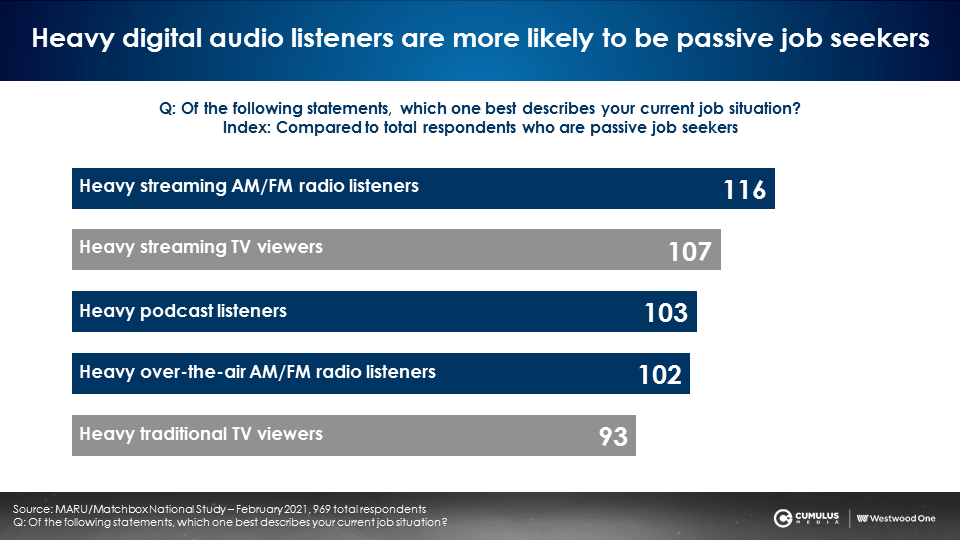
Reach job seekers on Rock, Oldies/Classic Hits, Adult Contemporary, News/Talk, and Top 40 AM/FM radio programming formats
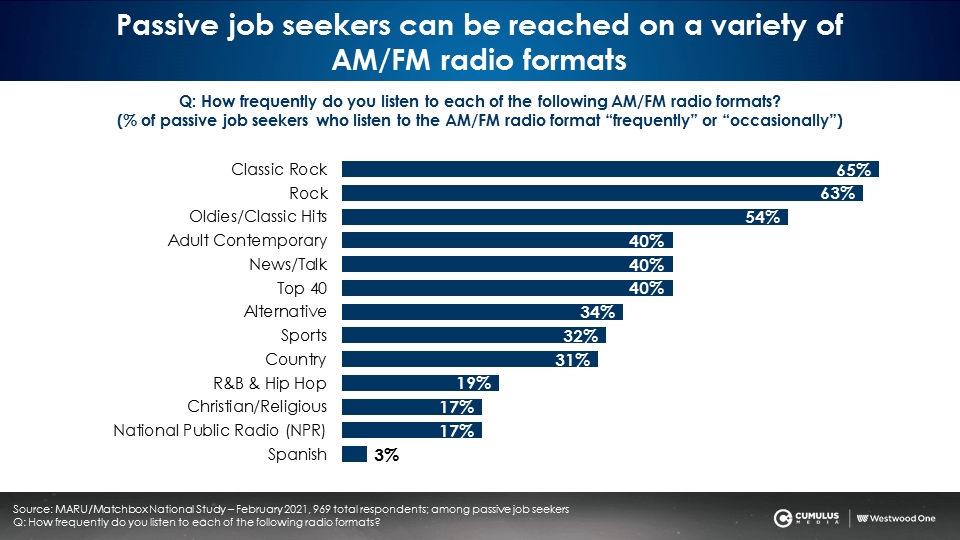
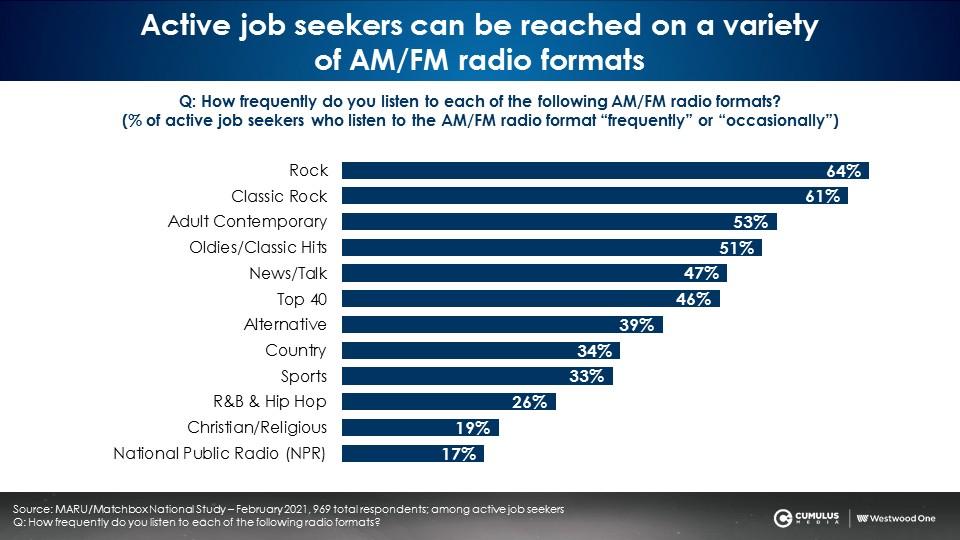
Key findings:
- Passive job seekers are the #1 source of new workers in America and outnumber active job seekers four to one
- Flexible at-home/on-site work opportunities are most compelling to passive job seekers
- Passive job seekers are less likely to use online job sites
- Passive job seekers are most aware of LinkedIn and Indeed
- Among active job seekers, it’s a two-horse race for familiarity and usage between LinkedIn and Indeed
- Audio is a great way to reach active and passive job seekers
- Reach job seekers on Rock, Oldies/Classic Hits, Adult Contemporary, News/Talk, and Top 40 AM/FM radio programming formats
Brittany Faison is the Insights Manager at CUMULUS MEDIA | Westwood One.
Contact the Insights team at CorpMarketing@westwoodone.com.